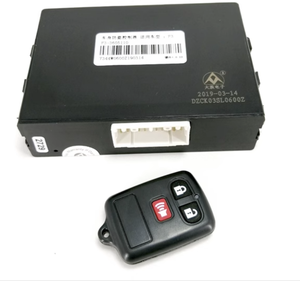(1280 products available)














































































































































































Bcm body control modules come in different types depending on the function it controls. They include:
Details of the BCM body control module are provided in the specifications section.
Power Supply
The BCM receives its power from the vehicle's electrical system. This power supply enables the BCM to operate and maintain its memory even when the ignition is turned off.
Communication Interfaces
The BCM communicates with other control modules in the vehicle through various communication networks, such as CAN (Controller Area Network) or LIN (Local Interconnect Network). These networks allow for real-time data exchange and coordination between modules.
Input and Output Channels
The BCM has multiple input and output channels to connect with various systems and components in the vehicle. Inputs may include signals from switches, sensors, or other modules, while outputs can drive actuators, relays, or signal outputs to other systems.
Integrated Circuits
The BCM contains specialized integrated circuits for processing and controlling various functions. These may include microcontrollers, memory chips, communication controllers, and dedicated circuits for specific tasks like controlling lighting or monitoring security systems.
Software and Programming
The functions and features of the BCM are determined by the software and programming. This software controls the logic, algorithms, and parameters for managing body systems and interfaces with other modules. The software may be updated or reprogrammed to accommodate new functions or improve performance.
Here is how to maintain the BCM in a vehicle:
Choosing the right Body Control Module for a vehicle requires careful consideration of several factors. First, it's important to understand the specific functions and controls managed by the BCM in the vehicle in question. Different vehicles may have variations in what the BCM controls, so knowing this will help in selecting the right module.
Compatibility with the vehicle's make, model, and year is crucial when choosing a BCM body control. This ensures that the module can communicate effectively with other systems in the vehicle without causing conflicts or malfunctions. Additionally, considering the features and functions of the BCM can help in selecting a module that suits specific needs. For instance, if keyless entry and central locking are important, choosing a BCM that supports these features is necessary.
Security features implemented in the BCM, such as encryption and authentication, should be considered when choosing the right module. These features help prevent unauthorized access and ensure the security of the vehicle. Budget considerations are also important, but it’s advisable to prioritize quality and reliability when choosing a Body Control Module. Cheaper options may lead to compatibility issues or failures, resulting in more significant costs down the line.
Warranty and support from the manufacturer or supplier should be considered when choosing a Body Control Module. This ensures that there is recourse in case of defects or issues with the module. Finally, consulting with a professional mechanic or automotive electrician can provide valuable insights and recommendations when choosing a Body Control Module for a vehicle.
Replacing a body control module can be a challenging task. However, it is not impossible to replace it without going to an auto electrician. Here are some steps to follow:
Before starting the process, ensure to get the right tools that will be needed.
Steps
Once the programming is done, the new body control module will be controlling all the body's functions.
Q1: What is BCM in a car?
A1: The Body Control Module, or BCM, is a significant component of a car's computer system. It manages and coordinates several body-related activities and systems, including lighting, power windows, central locking, and interior comfort features. Essentially, the BCM acts as a control hub, ensuring these systems function smoothly and communicate effectively.
Q2: What is the function of the Body Control Module?
A2: The Body Control Module (BCM) oversees various essential functions within the vehicle, including controlling lighting systems (headlights, taillights, and interior lights), managing door locks and windows, regulating keyless entry and ignition systems, monitoring vehicle security systems such as alarms or immobilizers, and interfacing with climate control settings like air conditioning or heating.
Q3: Can a vehicle operate without a Body Control Module?
A3: Technically, it is possible for a vehicle to operate without a Body Control Module (BCM), but it would require significant modifications. The BCM is integral to modern vehicles, coordinating and controlling various systems. Without it, many automated functions—such as lighting controls, door locking mechanisms, and security systems—would cease to operate, requiring manual control and increasing vulnerability to theft.
Q4: Where is the Body Control Module located in a vehicle?
A4: The Body Control Module (BCM) is typically situated within the vehicle's interior, often behind the dashboard, near the steering column, or under a seat. Its location is strategic to allow proximity to the systems it controls and communicates with the vehicle's main computer network.
Q5: What should be done if the Body Control Module malfunctions?
A5: Addressing a malfunctioning Body Control Module (BCM) is crucial for maintaining the vehicle's functionality and security. Users should first check the fuses and connections for any issues. If problems persist, professional diagnostic tools are necessary to identify the exact problem. In some cases, a software update or reprogramming may resolve the issue. If the BCM is damaged, replacing it with a compatible, reprogrammed unit is vital. Always consult a trained mechanic or the vehicle's service manual when dealing with BCM issues.